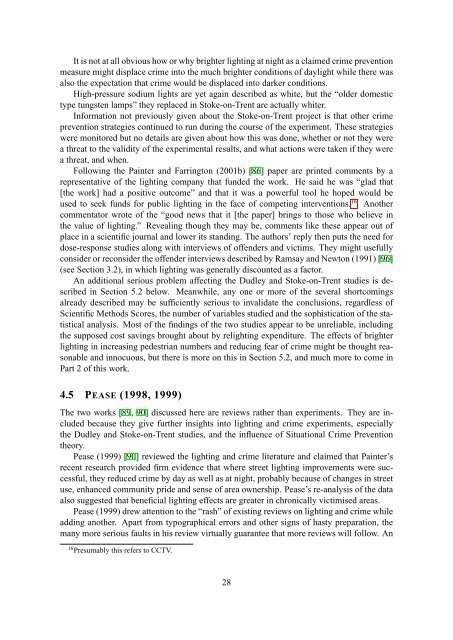outdoor lighting and crime, part 1 - Astronomical Society of Victoria
outdoor lighting and crime, part 1 - Astronomical Society of Victoria
outdoor lighting and crime, part 1 - Astronomical Society of Victoria
Create successful ePaper yourself
Turn your PDF publications into a flip-book with our unique Google optimized e-Paper software.
It is not at all obvious how or why brighter <strong>lighting</strong> at night as a claimed <strong>crime</strong> prevention<br />
measure might displace <strong>crime</strong> into the much brighter conditions <strong>of</strong> daylight while there was<br />
also the expectation that <strong>crime</strong> would be displaced into darker conditions.<br />
High-pressure sodium lights are yet again described as white, but the “older domestic<br />
type tungsten lamps” they replaced in Stoke-on-Trent are actually whiter.<br />
Information not previously given about the Stoke-on-Trent project is that other <strong>crime</strong><br />
prevention strategies continued to run during the course <strong>of</strong> the experiment. These strategies<br />
were monitored but no details are given about how this was done, whether or not they were<br />
a threat to the validity <strong>of</strong> the experimental results, <strong>and</strong> what actions were taken if they were<br />
a threat, <strong>and</strong> when.<br />
Following the Painter <strong>and</strong> Farrington (2001b) [86] paper are printed comments by a<br />
representative <strong>of</strong> the <strong>lighting</strong> company that funded the work. He said he was “glad that<br />
[the work] had a positive outcome” <strong>and</strong> that it was a powerful tool he hoped would be<br />
used to seek funds for public <strong>lighting</strong> in the face <strong>of</strong> competing interventions. 16 Another<br />
commentator wrote <strong>of</strong> the “good news that it [the paper] brings to those who believe in<br />
the value <strong>of</strong> <strong>lighting</strong>.” Revealing though they may be, comments like these appear out <strong>of</strong><br />
place in a scientific journal <strong>and</strong> lower its st<strong>and</strong>ing. The authors’ reply then puts the need for<br />
dose-response studies along with interviews <strong>of</strong> <strong>of</strong>fenders <strong>and</strong> victims. They might usefully<br />
consider or reconsider the <strong>of</strong>fender interviews described by Ramsay <strong>and</strong> Newton (1991) [96]<br />
(see Section 3.2), in which <strong>lighting</strong> was generally discounted as a factor.<br />
An additional serious problem affecting the Dudley <strong>and</strong> Stoke-on-Trent studies is described<br />
in Section 5.2 below. Meanwhile, any one or more <strong>of</strong> the several shortcomings<br />
already described may be sufficiently serious to invalidate the conclusions, regardless <strong>of</strong><br />
Scientific Methods Scores, the number <strong>of</strong> variables studied <strong>and</strong> the sophistication <strong>of</strong> the statistical<br />
analysis. Most <strong>of</strong> the findings <strong>of</strong> the two studies appear to be unreliable, including<br />
the supposed cost savings brought about by re<strong>lighting</strong> expenditure. The effects <strong>of</strong> brighter<br />
<strong>lighting</strong> in increasing pedestrian numbers <strong>and</strong> reducing fear <strong>of</strong> <strong>crime</strong> might be thought reasonable<br />
<strong>and</strong> innocuous, but there is more on this in Section 5.2, <strong>and</strong> much more to come in<br />
Part 2 <strong>of</strong> this work.<br />
4.5 PEASE (1998, 1999)<br />
The two works [89, 90] discussed here are reviews rather than experiments. They are included<br />
because they give further insights into <strong>lighting</strong> <strong>and</strong> <strong>crime</strong> experiments, especially<br />
the Dudley <strong>and</strong> Stoke-on-Trent studies, <strong>and</strong> the influence <strong>of</strong> Situational Crime Prevention<br />
theory.<br />
Pease (1999) [90] reviewed the <strong>lighting</strong> <strong>and</strong> <strong>crime</strong> literature <strong>and</strong> claimed that Painter’s<br />
recent research provided firm evidence that where street <strong>lighting</strong> improvements were successful,<br />
they reduced <strong>crime</strong> by day as well as at night, probably because <strong>of</strong> changes in street<br />
use, enhanced community pride <strong>and</strong> sense <strong>of</strong> area ownership. Pease’s re-analysis <strong>of</strong> the data<br />
also suggested that beneficial <strong>lighting</strong> effects are greater in chronically victimised areas.<br />
Pease (1999) drew attention to the “rash” <strong>of</strong> existing reviews on <strong>lighting</strong> <strong>and</strong> <strong>crime</strong> while<br />
adding another. A<strong>part</strong> from typographical errors <strong>and</strong> other signs <strong>of</strong> hasty preparation, the<br />
many more serious faults in his review virtually guarantee that more reviews will follow. An<br />
16 Presumably this refers to CCTV.<br />
28
















